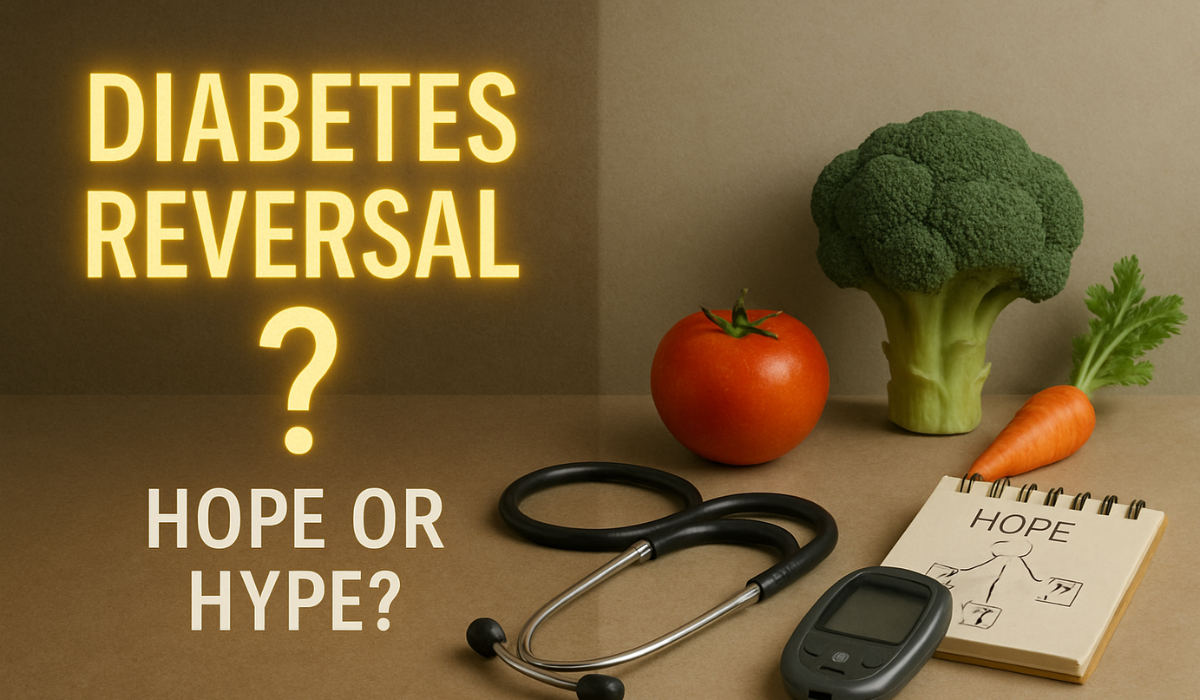Diabetes Reversal or Just Another Illusion? A Truthful Take on What Really Matters
“Reverse your diabetes in 30 days!”
“Throw away your medications forever!”
“Unlock the secret no doctor will tell you!”
We’ve all seen these bold claims—on social media, in wellness ads, or sold by influencers with no medical background. They sound tempting. They offer hope. But they often distract us from what truly works and can quietly lead us down a path of more harm than healing.
The truth? Quick fixes often come with hidden consequences. And when it comes to diabetes, the cost of chasing shortcuts can go far beyond your wallet.
What Should We Really Focus On?
1. Consistent, Personalized Nutrition
Forget crash diets, trendy detoxes, or “superfood cures.” Real progress comes from building a sustainable eating plan that matches your body’s needs.
-
Focus on low Glycemic Index (GI) foods that release sugar slowly into your bloodstream.
-
Include a balance of fiber-rich vegetables, lean proteins, and healthy fats.
-
Avoid highly processed foods, trans fats, and excessive hidden sugars.
Why Glycemic Index Matters:
Choosing low-GI foods helps to prevent sharp blood sugar spikes and crashes, reducing the strain on your insulin response over time. Understanding GI—and also Glycemic Load (which considers portion size)—is crucial for smarter meal planning.
2. Sustainable Physical Activity
You don’t need to sign up for an ultra-marathon or crush yourself with extreme workouts.
-
Aim for at least 150 minutes of moderate activity per week—this could be brisk walking, swimming, dancing, or cycling.
-
Include strength training twice a week to help improve insulin sensitivity and preserve muscle mass.
-
Remember, movement throughout the day matters too: short walks after meals can significantly reduce post-meal blood sugar levels.
3. Stress and Sleep Management
We often underestimate the hormonal chaos that chronic stress and poor sleep can trigger.
-
Chronic stress raises cortisol, a hormone that can spike blood sugar levels.
-
Lack of sleep impairs insulin sensitivity and increases cravings for sugary foods.
Incorporate stress-relief practices like meditation, deep breathing, journaling, or even a simple hobby you enjoy. Prioritize 7–9 hours of quality sleep every night.
4. Understanding and Managing Carbohydrates Wisely
Instead of fearing carbs, learn to choose smart carbs.
-
Favor complex carbohydrates such as quinoa, brown rice, oats, and legumes.
-
Combine carbs with proteins or fats to slow down sugar absorption.
-
Pay attention to portion sizes; even healthy foods can cause spikes if overconsumed.
5. Regular Health Monitoring and Medical Supervision
No diet or supplement replaces the need for regular monitoring.
-
Keep track of your HbA1c levels, fasting blood sugar, post-meal sugar, and other vital parameters.
-
Stay in touch with your healthcare provider for ongoing evaluation and medication adjustments if necessary.
A supervised approach ensures you spot early warning signs and prevent complications like neuropathy, kidney issues, or cardiovascular risks.
6. Gut Health and Inflammation Control
Emerging research shows that gut health plays a major role in metabolic diseases.
-
Include probiotics (like yogurt, kefir, fermented foods) and prebiotics (fiber-rich foods like onions, garlic, asparagus).
-
Reduce foods that promote inflammation—especially highly processed foods and excessive sugars.
A healthier gut microbiome can support better glucose metabolism and immune function.
7. Mindset: It’s a Journey, Not a Race
This might be the most important point.
Sustainable health transformations don’t happen overnight—and that’s okay.
-
Set realistic, achievable goals.
-
Celebrate small victories—like lower sugar readings, better energy, or improved sleep.
-
Understand that setbacks are normal—what matters is consistency, not perfection.
These steps may not promise an overnight transformation. But they protect you from serious complications, and help you build health from the inside out.
The Hidden Dangers of False Promises
Here’s what rarely gets talked about when we follow unverified “reversal” paths:
- Stopping medications without medical supervision
Some programs encourage people to drop their prescribed medication as a sign of “success.” But doing this without your doctor’s guidance can cause serious spikes or crashes in blood sugar—putting your life at risk. - Delaying real treatment
Believing you’ve found a shortcut often causes people to pause what’s actually helping them—whether it’s dietary changes, exercise, or proven medications. In that time, silent damage can occur. - Impact on other organs
Diabetes doesn’t stay in a silo. When unmanaged, it can quietly affect your kidneys, eyes, heart, nerves, and even brain function. By the time symptoms appear, the damage is often harder to reverse. - Emotional exhaustion and disappointment
When false hope crashes, it leaves behind frustration, guilt, and distrust. And that emotional burden can lead people to give up entirely.
Real Change Takes Time—And That’s Okay
Instead of asking, “How quickly can I reverse diabetes?”—a more powerful question is:
“What consistent actions can I take to feel better, reduce complications, and live freely?”
The goal is not a 30-day miracle. The goal is real progress.
And real progress is always safer, more sustainable, and backed by science—not just salesmanship.
A Thoughtful Suggestion
If you’re feeling overwhelmed by all the noise around diabetes “reversal,” take a step back. Ask better questions. Seek qualified guidance. And give your body the gift of sustainable, supported change.
Start with what’s real. Stick with what works.
Because your health isn’t a trend—it’s your foundation.



